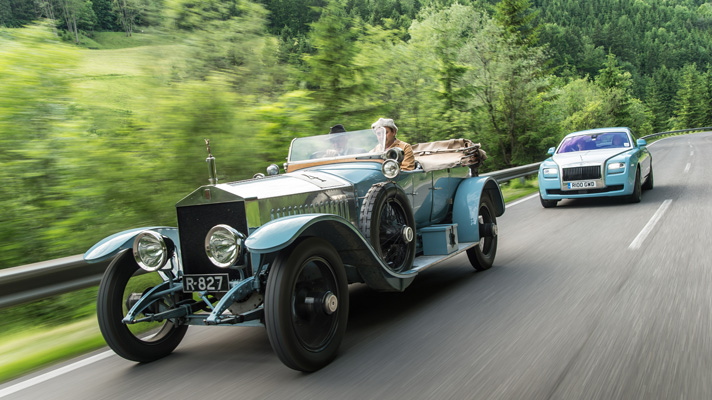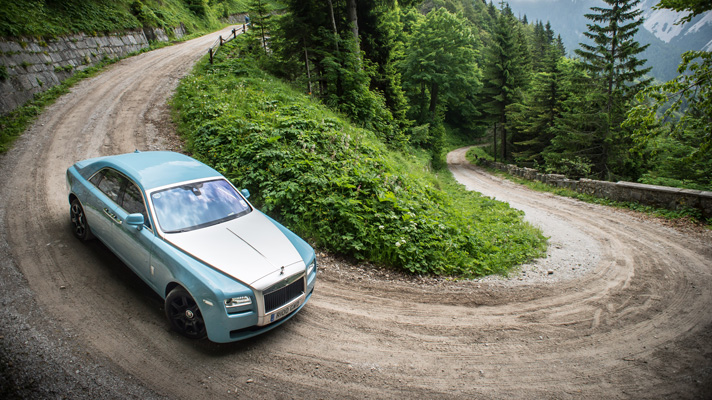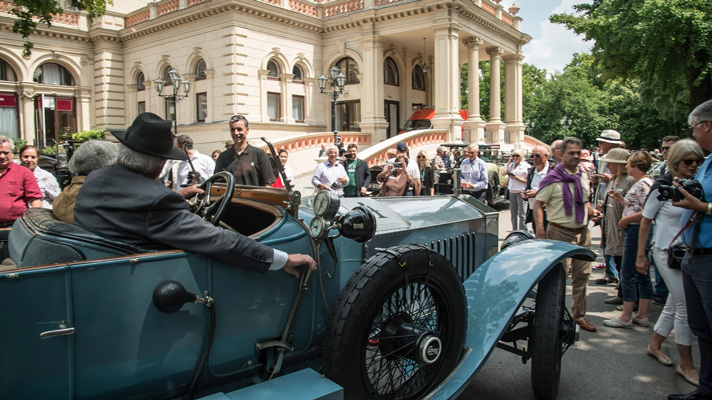
100 years later, we drive the 1913 Alpine Trial
26 million quid. That's what a conservative sort would value the contents of this car park in Vienna, where 48 incredibly old, incredibly rare Rolls-Royce Ghosts are quietly leaking oil. Which, considering the circumstances, is pretty impressive - each one has just finished an 1850-mile, 16-day trek through the most gruelling Alpine roads known to lunacy. With no front brakes, tyres the width of iPhones, and an operational procedure that demands an immense amount of the very cleverest thought.
Rewind 100 years to the day, and at this very spot, you'd be presented with a scene that's, well... entirely different. But give or take a few revolutionaries (Stalin and Trotsky lived there at the time) you'd notice something familiar. See the blue Ghost with the bare alloy bonnet? That very car had just completed a near-identical route through the mountains, competing in the 1913 Alpine Trial.
The Alpine what? It was a reliability run, started in 1910, devised with the singular purpose of destroying cars. Before the First World War, it was known as the toughest rally in Europe, traversing Austria, Croatia, Slovenia and Italy. All the big-hitters - Bugatti, Daimler, Audi - battled it out in standard(ish) cars on public roads for the provenance, and associated sales. Like a pre-War combo of WRC and LeMans, but with more tweed. It also earned Rolls the moniker ‘best car in the world' after a privateer driver, James Radley, finished first in each stage during the 1913 running, exactly 100 years ago. His car lives on today, and it's participating in a centennial re-enactment organised by the 20-Ghost Club - something that's moved modern Rolls-Royce to build a limited edition Alpine Trial Centenary Ghost to support the endeavour.
It's also why an army of insects is currently grazing on the vast, delicious mountain of flesh that is me - TopGear.com's embedded itself in the original Radley car for the final few miles of the event. And there's a cloud of mosquitos above the open-top Silver Ghost, casually devouring owner/driver John Kennedy and I as we slowly wind up an alp that straddles the Austrian/Slovenian border.
"There's something pretty special about this," says John, while he punches and kicks his way through a double-declutch gearchange, simultaneously adjusting the air-fuel mixture on a lever mounted in the middle of the steering wheel. "I've done about 200,000 kilometers in this car, and driven the route before, but knowing you're driving the car in roughly the same place as it was exactly 100 years ago is a proper testament to these machines.
"You've got to be careful on roads like these, though. You can get away with driving older cars incorrectly in England - keeping them in too low a gear, or letting them get too hot - but if you do it wrong over here, and on a mountain pass, you'll get found out. Which tends to cost you a bit. But drive them properly and they're incredibly capable." Which is precisely what Rolls-Royce was trying prove by taking part in the event, 100 years ago. Well, that and saving face...
The previous year, Radley, an aviator and, ostensible man about Mayfair, entered his 1912 Silver Ghost. But he wildly underestimated the severity and gearing required for heaving his three-speed car up a mountain, speccing it for top speed, not low-ratio clambery. At the end of day 1, his car came to a gentle halt on the steepest part of his route, toys exited the pram and he retired himself from the rally.
This threw a spanner into the Rolls-Royce PR machine, so the following year, on hearing Radley was planning to have another go, they decided to both test and prep his car, and send a couple of other Ghosts along with it. A four-speed gearbox was developed with an extra-low gear for the steeper gradiants, the chassis and suspension were beefed up, the fuel tank was inflated, another reserve tank was strapped on for non-stop running, and a new starting system was engineered to conform to the rally's regs (all bonnets had to be sealed and engines started within one minute).
As our presence here suggests, the development work was a success. The Ghosts came first, second, third and fourth on all but one of the stages, and as Rolls-Royce insists on reminding us, it was here the company built its reputation for building ‘the best car in the world,' and, more importantly, sales in Europe grew to match those in the UK on the back of its triumph, while still maintaining the improbable comfort levels you'd expect from the marque.
Even 100 years on, you can see what the fuss was about. Postured on the button-tucked front bench which looks like it's been commissioned by the 4th Earl of Chesterfield, and contemplating the bare behind of of Radley's one-off radiator mascot (he chose a lady in the throes of ecstasy to keep his coolant in, rather than one in the spirit of it), you can't help but notice how ethereally it proceeds. This car, as British as the empire, only slightly larger, has a suppleness to it that isolates you from the road without ever alienating, even though it uses semi-eliptical leaf springs all-round. Getting horse-and-trap tech to work like this really is testament to the vast, whole engineering integrity that made Rolls-Royce a benchmark.
Top Gear
Newsletter
Thank you for subscribing to our newsletter. Look out for your regular round-up of news, reviews and offers in your inbox.
Get all the latest news, reviews and exclusives, direct to your inbox.
It manages a reasonable lick, too - in top gear, it'll do 60mph comfortably - Veyron-quick by turn of the century standards, thanks to the elephant gun under the bonnet. It's a 7.4-litre straight six, that idles at 180rpm (yep, one hundred and eighty), each cylinder with more than a litre of its own capacity.
The only time it shows its age is the bottom-puckering procedure of slowing down. The rear-only drum brakes, which work about as well as drums than they do as brakes, tend to get a bit... overheaty. And then stop working - which imposes a unique challenge when you're attempting to pull up to relieve yourself while facing downhill on a mountain road. There is a middle pedal, but it slows down the axle at the transmission, and overuse tends to have costly, destructive consequences. A shortcoming that's pleasingly absent from the 2014 iteration.
Come to think of it, beyond a few casual nods, there isn't much the two cars have in common. Yes, the one-of-35 special edition Ghost shares the Radley car's black wheels, blue paint, naked alloy bonnet, and black grill. But what else? Well, beside the badge that BMW paid £40m for back in 1998... Technologically, nothing. There are twice as many cylinders, and at 6.6 litres, a little less displacement. And thanks to a pair of turbochargers, the young gun's good for 563bhp, 575lb ft, and 0-62mph time of 4.7 seconds (unchanged from the normal Ghost). Then there's the suspension. It gets the full suite of air-ride technology - a system so sensitive that it can tell if someone in the back moves from one side of the car to the other, and adjust itself accordingly. It's also the first Rolls to get Satellite-Aided Transmission, which uses GPS mapping to work out the terrain approaching, mash that info with what it knows about your driving style, and make sure that you're always in the right gear.
But the two share a distinct philosophy. Call it purity of purpose. They're both the result of endless, uncompromising refinement. To drive, they glide down the road like a walnut and aluminium mudslide, never sporting, but supremely confident. To the passenger, they're an arm round the shoulder in a world gone mad. The sort of qualities you'd only find in the world's best cars.
Back in the 1913 Ghost, we're on the final approach to Vienna. John points out the stretches of road originally used in the Alpine Rally that now belong to the 21st century - industrial estates, bike lanes, or simply bypassed and returning to nature. ‘It is sad that we can't be completely faithful, but this [event] is much more than just recreating an old route - it's showing what the Ghost is capable of. A lot of cars like this are kept locked up in collections and sealed in bubbles, and yes, they are valuable and in some sense need to be preserved. But ultimately, they aren't worth anything if they're not driven. It's good to remind people that they can be. And quite hard."
Words: Matthew Jones
Photos: Jamie Lipman










